trailer TOYOTA LAND CRUISER 2021 Owners Manual (in English)
[x] Cancel search | Manufacturer: TOYOTA, Model Year: 2021, Model line: LAND CRUISER, Model: TOYOTA LAND CRUISER 2021Pages: 632, PDF Size: 13.87 MB
Page 3 of 632
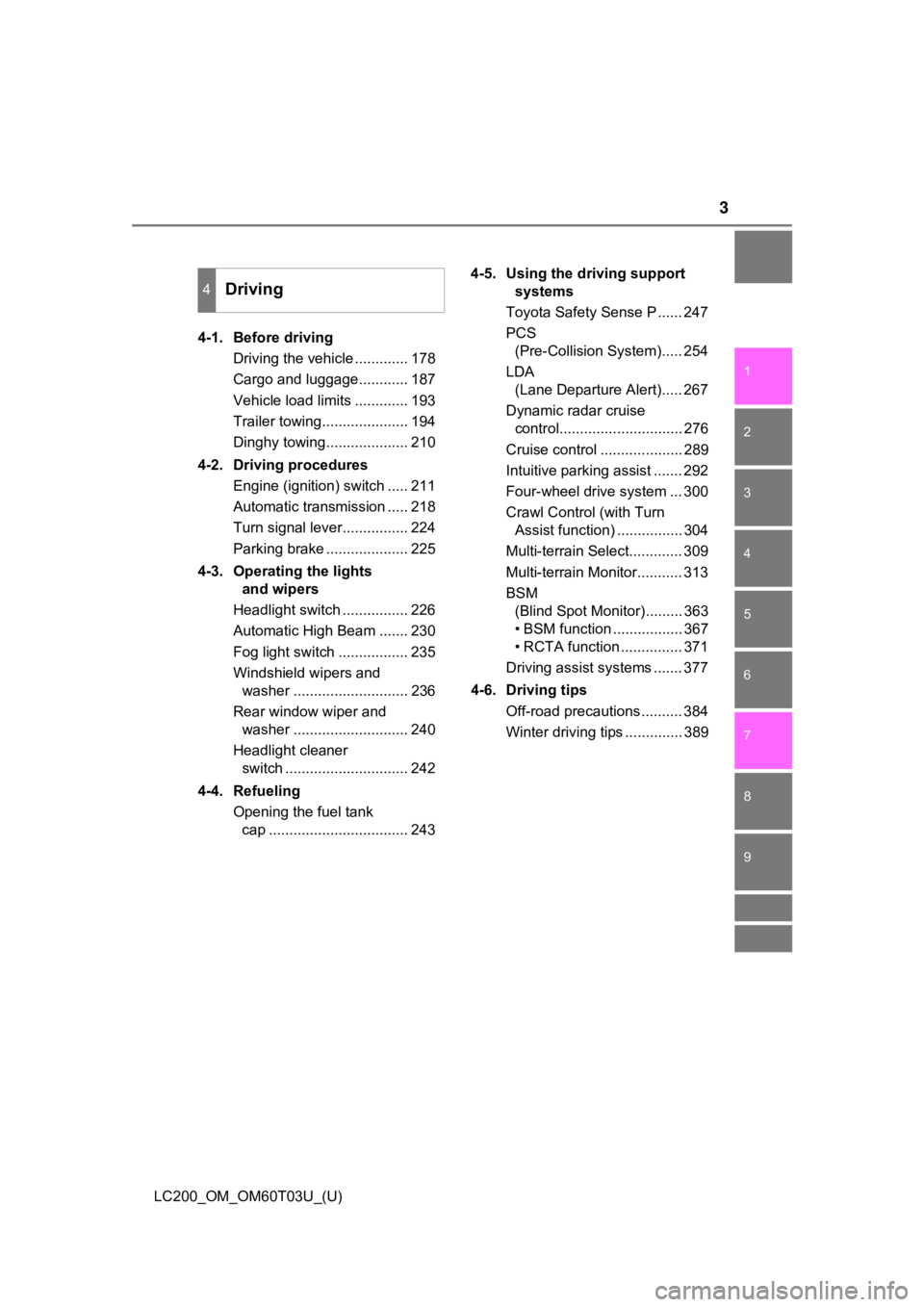
3
1
8 7
6
5
4
3
2
LC200_OM_OM60T03U_(U)
9
4-1. Before drivingDriving the vehicle ............. 178
Cargo and luggage............ 187
Vehicle load limits ............. 193
Trailer towing..................... 194
Dinghy towing.................... 210
4-2. Driving procedures Engine (ignition) switch ..... 211
Automatic transmission ..... 218
Turn signal lever................ 224
Parking brake .................... 225
4-3. Operating the lights and wipers
Headlight switch ................ 226
Automatic High Beam ....... 230
Fog light switch ................. 235
Windshield wipers and washer ............................ 236
Rear window wiper and washer ............................ 240
Headlight cleaner switch .............................. 242
4-4. Refueling Opening the fuel tank cap .................................. 243 4-5. Using the driving support
systems
Toyota Safety Sense P ...... 247
PCS (Pre-Collision System)..... 254
LDA (Lane Departure Alert)..... 267
Dynamic radar cruise control.............................. 276
Cruise control .................... 289
Intuitive parking assist ....... 292
Four-wheel drive system ... 300
Crawl Control (with Turn Assist function) ................ 304
Multi-terrain Select............. 309
Multi-terrain Monitor........... 313
BSM (Blind Spot Monitor)......... 363
• BSM function ................. 367
• RCTA function ............... 371
Driving assist systems ....... 377
4-6. Driving tips Off-road precautions .......... 384
Winter driving tips .............. 389
4Driving
Page 177 of 632

177
LC200_OM_OM60T03U_(U)
4Driving
4-1. Before drivingDriving the vehicle ............. 178
Cargo and luggage ........... 187
Vehicle load limits ............. 193
Trailer towing..................... 194
Dinghy towing ................... 210
4-2. Driving procedures Engine (ignition) switch ..... 211
Automatic transmission ..... 218
Turn signal lever................ 224
Parking brake .................... 225
4-3. Operating the lights and wipers
Headlight switch ................ 226
Automatic High Beam ....... 230
Fog light switch ................. 235
Windshield wipers and washer ............................ 236
Rear window wiper and washer ............................ 240
Headlight cleaner switch .............................. 242 4-4. Refueling
Opening the fuel tank cap .................................. 243
4-5. Using the driving support systems
Toyota Safety Sense P ..... 247
PCS (Pre-Collision System) .... 254
LDA (Lane Departure Alert) .... 267
Dynamic radar cruise control ............................. 276
Cruise control .................... 289
Intuitive parking assist....... 292
Four-wheel drive system ... 300
Crawl Control (with Turn Assist function) ............... 304
Multi-terrain Select ............ 309
Multi-terrain Monitor .......... 313
BSM (Blind Spot Monitor) ........ 363
• BSM function ................ 367
• RCTA function .............. 371
Driving assist systems ...... 377
4-6. Driving tips Off-road precautions ......... 384
Winter driving tips ............. 389
Page 179 of 632

LC200_OM_OM60T03U_(U)
1794-1. Before driving
4
Driving
■When starting off on an uphill
Hill-start assist control is activated. ( P. 377)
■ Driving in the rain
●Drive carefully when it is raining, because visibility will be reduced, the win-
dows may become fogged-up, and the road will be slippery.
● Drive carefully when it starts to rain, because the road surface will be espe-
cially slippery.
● Refrain from high speeds when driving on an expressway in the r ain,
because there may be a layer of water between the tires and the road sur-
face, preventing the steering and brakes from operating properl y.
■ Engine speed while driving
In the following conditions, the engine speed may become high while driving.
This is due to automatic up-shifting control or down-shifting implementation to
meet driving conditions. It does not indicate sudden acceleration.
●The vehicle is judged to be driving uphill or downhill
● When the accelerator pedal is released
● When the brake pedal is depressed
■ Restraining engine output (Brake Override System)
●When the accelerator and brake pedals are depressed at the same time, the
engine output may be restrained.
● A warning message is displayed on the multi-information display while the
system is operating. If a warning message is shown on the multi -information
display, read the message and follow the instructions.
■ Breaking in your new Toyota
To extend the life of the vehicle, observing the following prec autions is recom-
mended:
● For the first 200 miles (300 km):
Avoid sudden stops.
● For the first 500 miles (800 km):
Do not tow a trailer.
● For the first 600 miles (1000 km):
• Do not drive at extremely high speeds.
• Avoid sudden acceleration.
• Do not drive continuously in the low gears.
• Do not drive at a constant speed for extended periods.
Page 188 of 632

188
LC200_OM_OM60T03U_(U)
4-1. Before driving
Cargo capacity depends on the total weight of the occupants.
(Cargo capacity) = (Total load capacity) (Total weight of occupants)
Steps for Determini ng Correct Load Limit
(1) Locate the statement “The co mbined weight of occupants and
cargo should never exceed XXX kg or XXX lbs.” on your vehicle’s
placard.
(2) Determine the combined weight of the driver and passengers t hat
will be riding in your vehicle.
(3) Subtract the combined weight of the driver and passengers fr om
XXX kg or XXX lbs.
(4) The resulting figure equals the available amount of cargo an d lug-
gage load capacity.
For example, if the “XXX” amount equals 1400 lbs. and there wil l be
five 150 lb passengers in your vehicle, the amount of available
cargo and luggage load capacity is 650 lbs. (1400 750 (5150) =
650 lbs.)
(5) Determine the combined weight of luggage and cargo being loa ded
on the vehicle. That weight may n ot safely exceed the available
cargo and luggage load capac ity calculated in Step 4.
(6) If your vehicle will be towing a trailer, load from your tra iler will be
transferred to your vehicle. Consult this manual to determine h ow
this reduces the available cargo and luggage load capacity of y our
vehicle. ( P. 193)
Capacity and distribution
Page 193 of 632
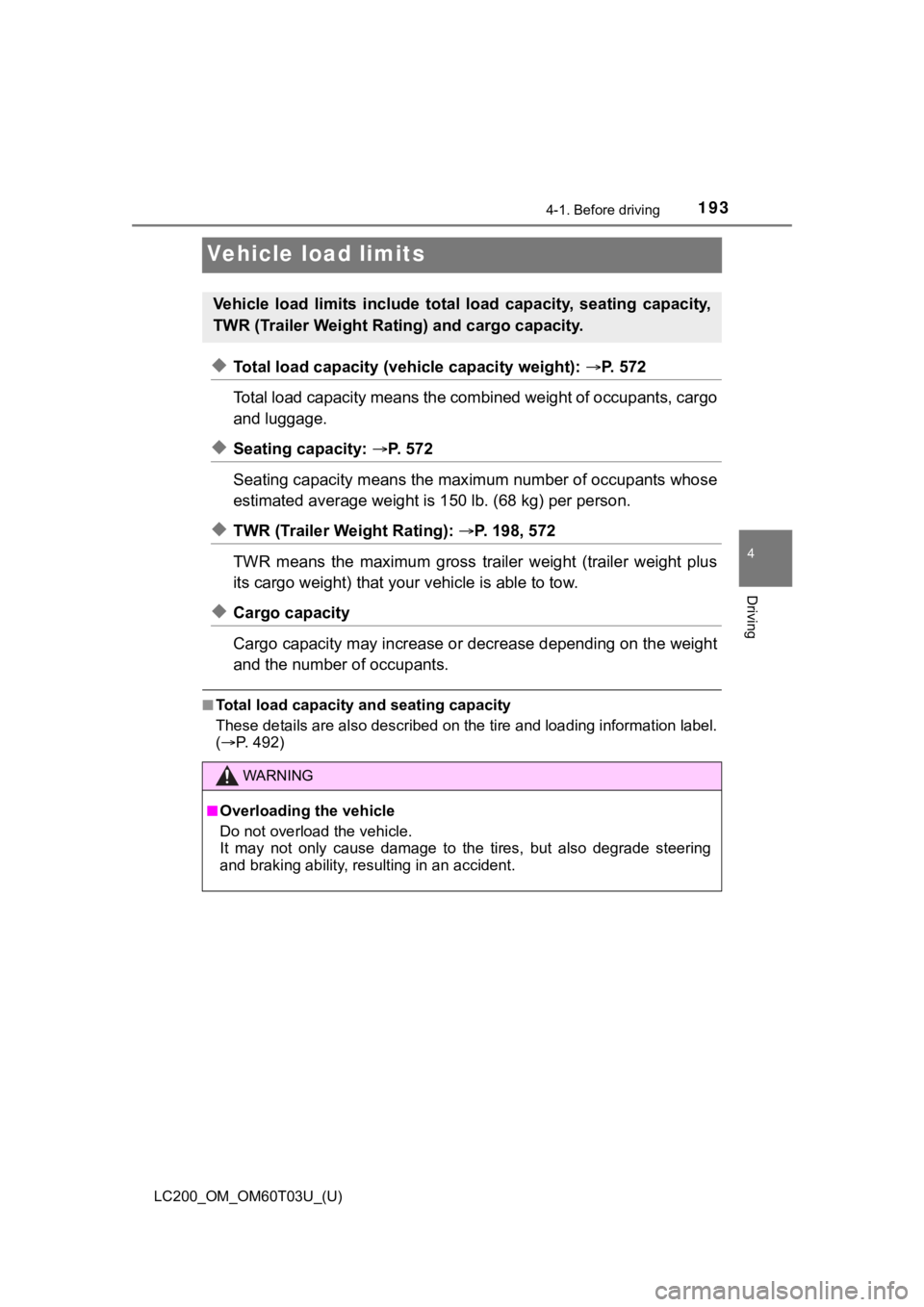
193
LC200_OM_OM60T03U_(U)
4-1. Before driving
4
Driving
Vehicle load limits
◆Total load capacity (vehicle capacity weight): P. 572
Total load capacity means the co mbined weight of occupants, cargo
and luggage.
◆Seating capacity: P. 5 7 2
Seating capacity means the max imum number of occupants whose
estimated average weight is 1 50 lb. (68 kg) per person.
◆TWR (Trailer Weight Rating): P. 198, 572
TWR means the maximum gross trai ler weight (trailer weight plus
its cargo weight) that your vehicle is able to tow.
◆Cargo capacity
Cargo capacity may increase or decrease depending on the weight
and the number o f occupants.
■Total load capacity and seating capacity
These details are also described on the tire and loading inform ation label.
( P. 492)
Vehicle load limits include total load capacity, seating capaci ty,
TWR (Trailer Weight Rati ng) and cargo capacity.
WARNING
■Overloading the vehicle
Do not overload the vehicle.
It may not only cause damage to the tires, but also degrade steering
and braking ability, res ulting in an accident.
Page 194 of 632
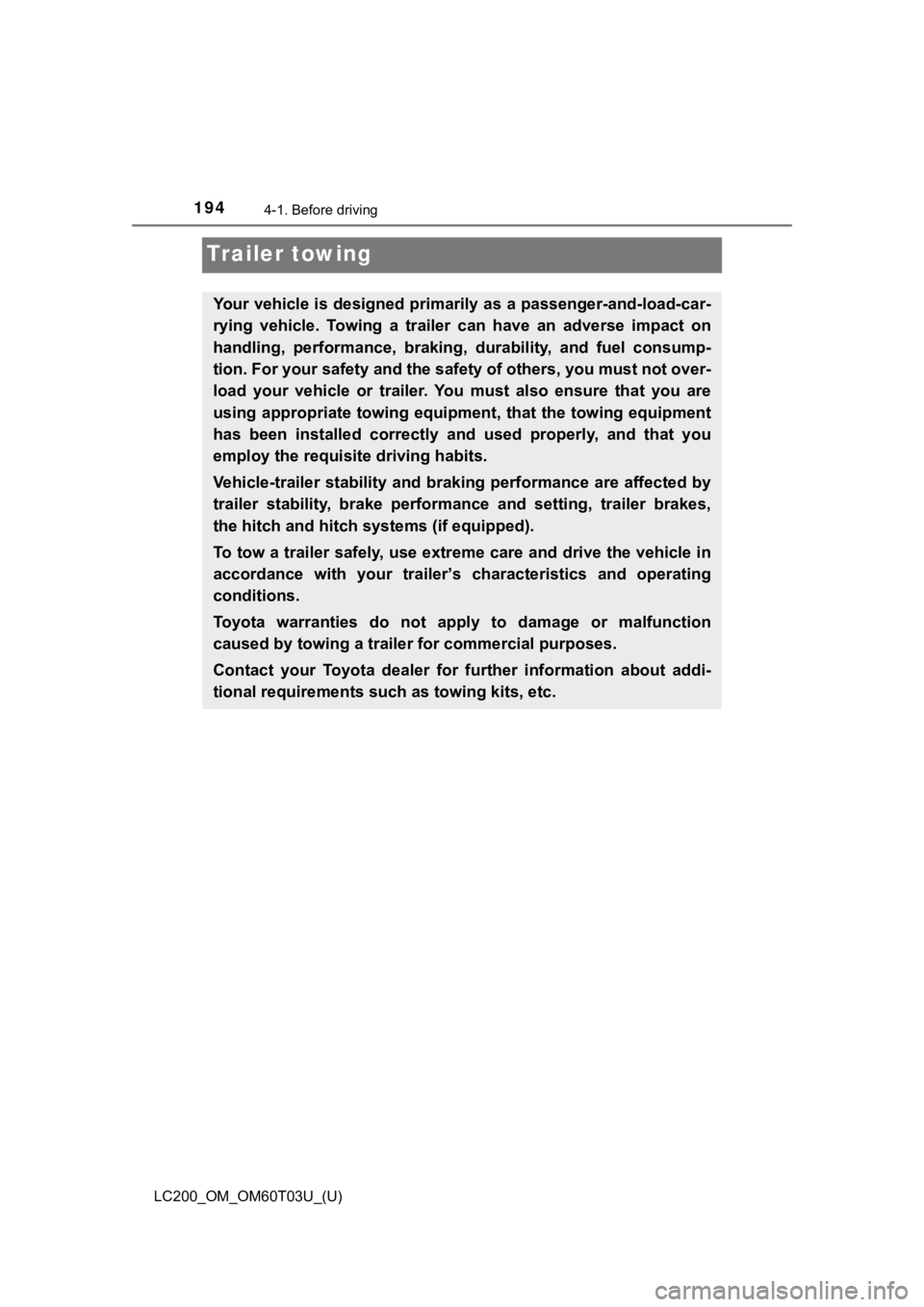
194
LC200_OM_OM60T03U_(U)
4-1. Before driving
Trailer towing
Your vehicle is designed primarily as a passenger-and-load-car-
rying vehicle. Towing a trailer can have an adverse impact on
handling, performance, braking, durability, and fuel consump-
tion. For your safety and the safety of others, you must not ov er-
load your vehicle or trailer. You must also ensure that you are
using appropriate towing equipm ent, that the towing equipment
has been installed correctly a nd used properly, and that you
employ the requisi te driving habits.
Vehicle-trailer stability and braking performance are affected by
trailer stability, brake performance and setting, trailer brake s,
the hitch and hitch systems (if equipped).
To tow a trailer safely, use extreme care and drive the vehicle in
accordance with your trailer’s characteristics and operating
conditions.
Toyota warranties do not apply to damage or malfunction
caused by towing a trailer for commercial purposes.
Contact your Toyota dealer for further information about addi-
tional requirements such as towing kits, etc.
Page 195 of 632
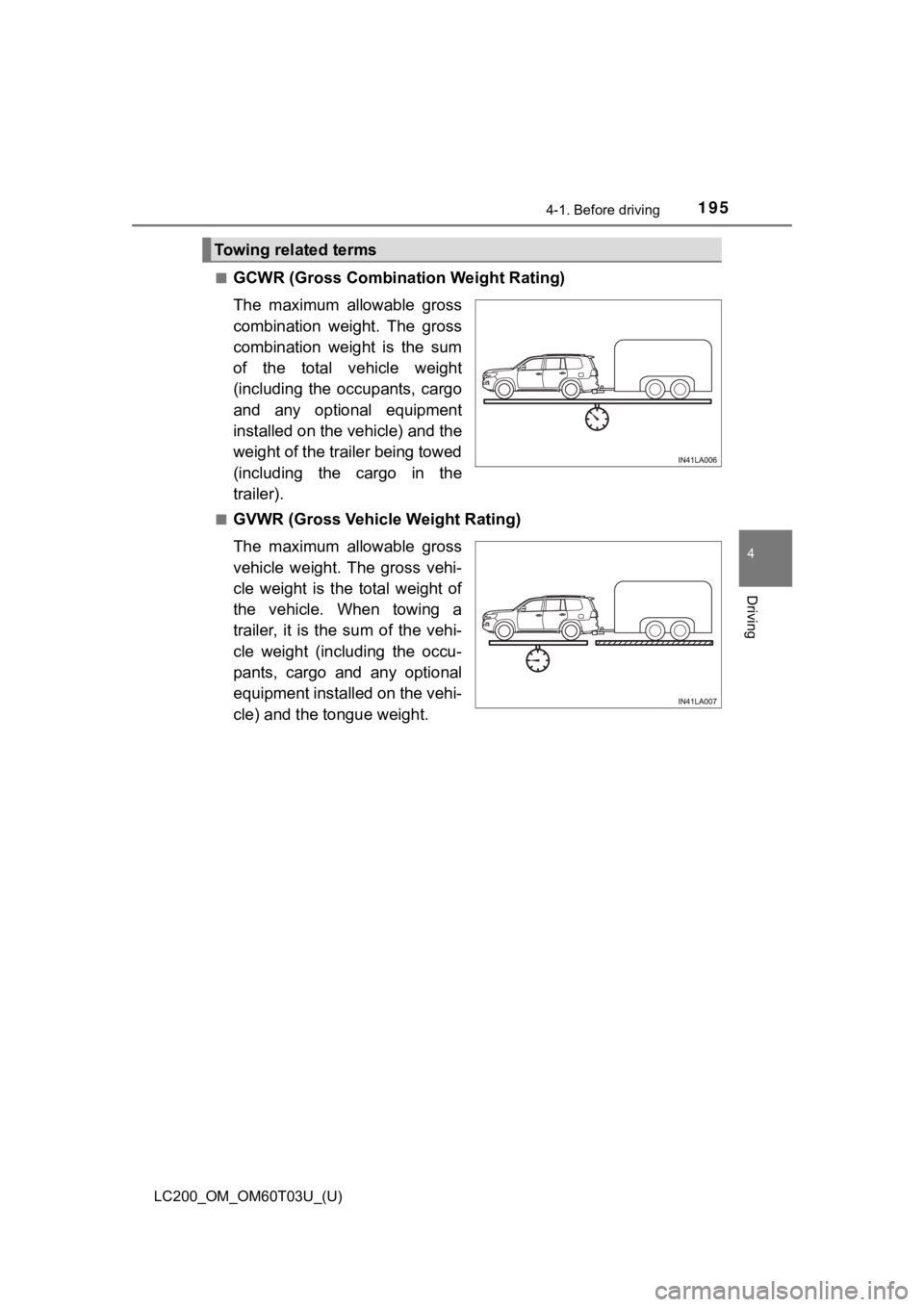
LC200_OM_OM60T03U_(U)
1954-1. Before driving
4
Driving
■GCWR (Gross Combination Weight Rating)
The maximum allowable gross
combination weight. The gross
combination weight is the sum
of the total vehicle weight
(including the occupants, cargo
and any optional equipment
installed on the vehicle) and the
weight of the trailer being towed
(including the cargo in the
trailer).
■GVWR (Gross Vehicle Weight Rating)
The maximum allowable gross
vehicle weight. The gross vehi-
cle weight is the total weight of
the vehicle. When towing a
trailer, it is the sum of the vehi-
cle weight (including the occu-
pants, cargo and any optional
equipment installed on the vehi-
cle) and the tongue weight.
Towing related terms
Page 196 of 632
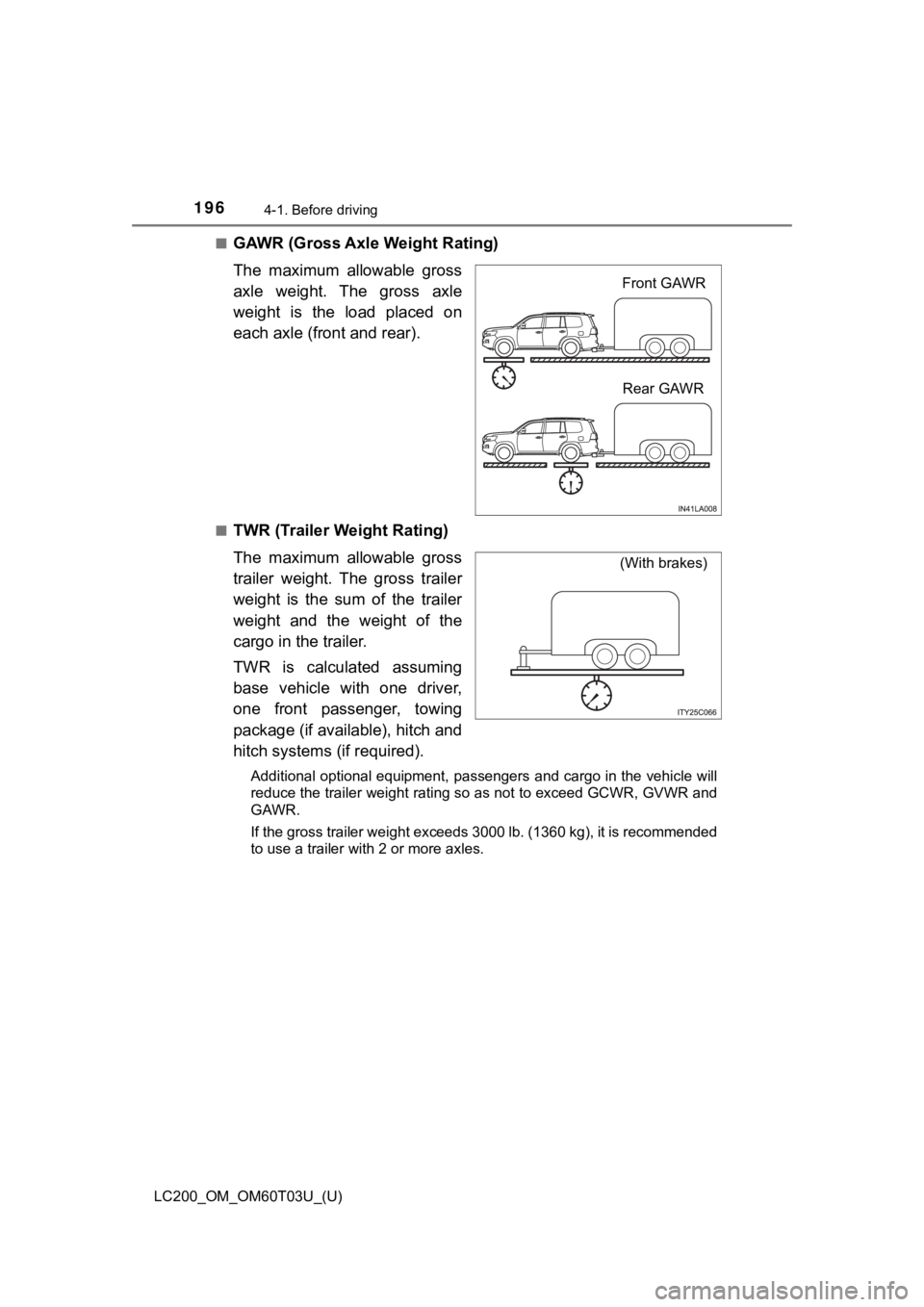
196
LC200_OM_OM60T03U_(U)
4-1. Before driving
■GAWR (Gross Axle Weight Rating)
The maximum allowable gross
axle weight. The gross axle
weight is the load placed on
each axle (front and rear).
■TWR (Trailer Weight Rating)
The maximum allowable gross
trailer weight. The gross trailer
weight is the sum of the trailer
weight and the weight of the
cargo in the trailer.
TWR is calculated assuming
base vehicle with one driver,
one front passenger, towing
package (if available), hitch and
hitch systems (if required).
Additional optional equipment, passengers and cargo in the vehicle will
reduce the trailer weight rating so as not to exceed GCWR, GVWR and
GAWR.
If the gross trailer weight exceeds 3000 lb. (1360 kg), it is r ecommended
to use a trailer with 2 or more axles.
Front GAWR
Rear GAWR
(With brakes)
Page 197 of 632
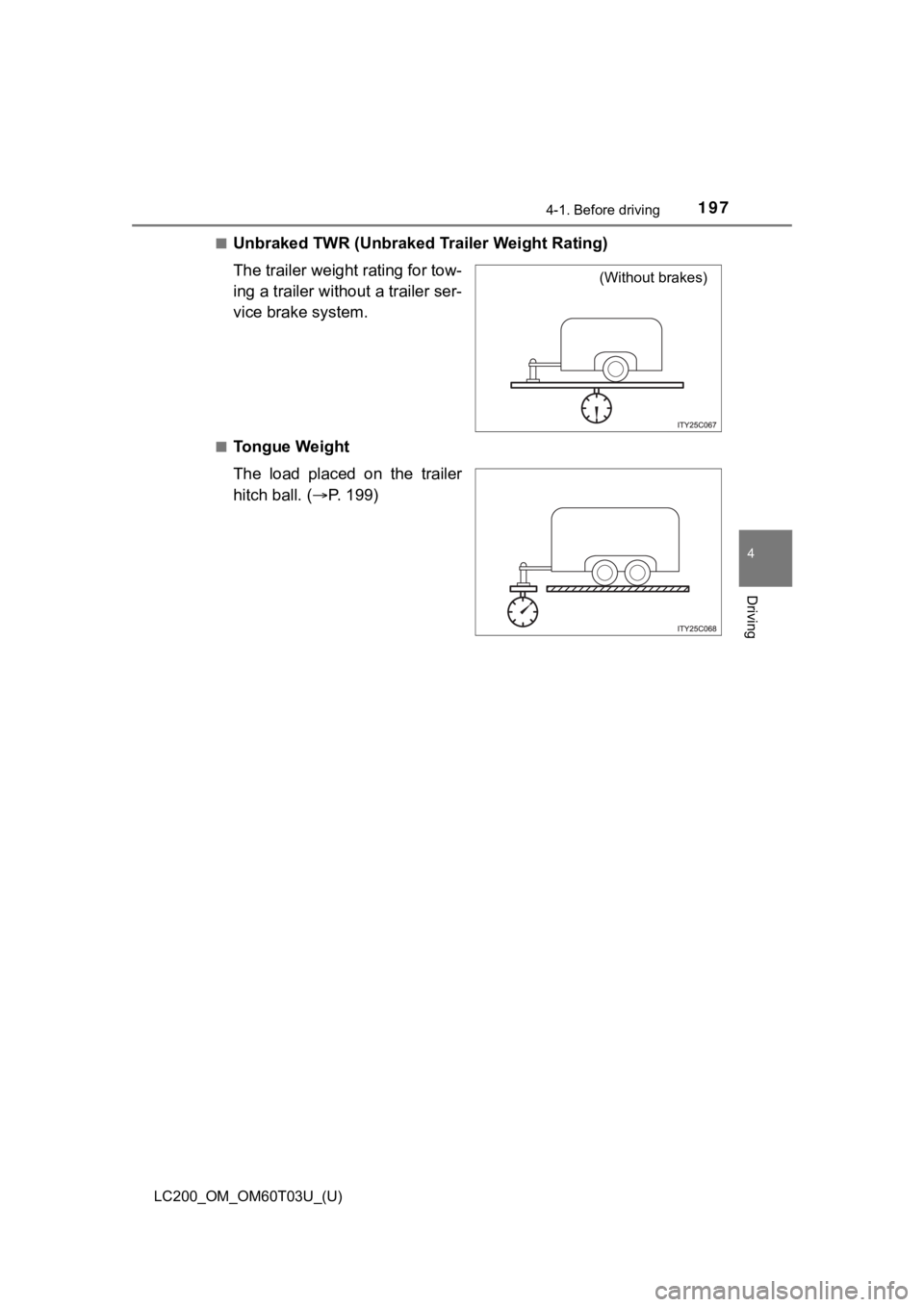
LC200_OM_OM60T03U_(U)
1974-1. Before driving
4
Driving
■Unbraked TWR (Unbraked Trailer Weight Rating)
The trailer weight rating for tow-
ing a trailer without a trailer ser-
vice brake system.
■Tongue Weight
The load placed on the trailer
hitch ball. (P. 199)
(Without brakes)
Page 198 of 632
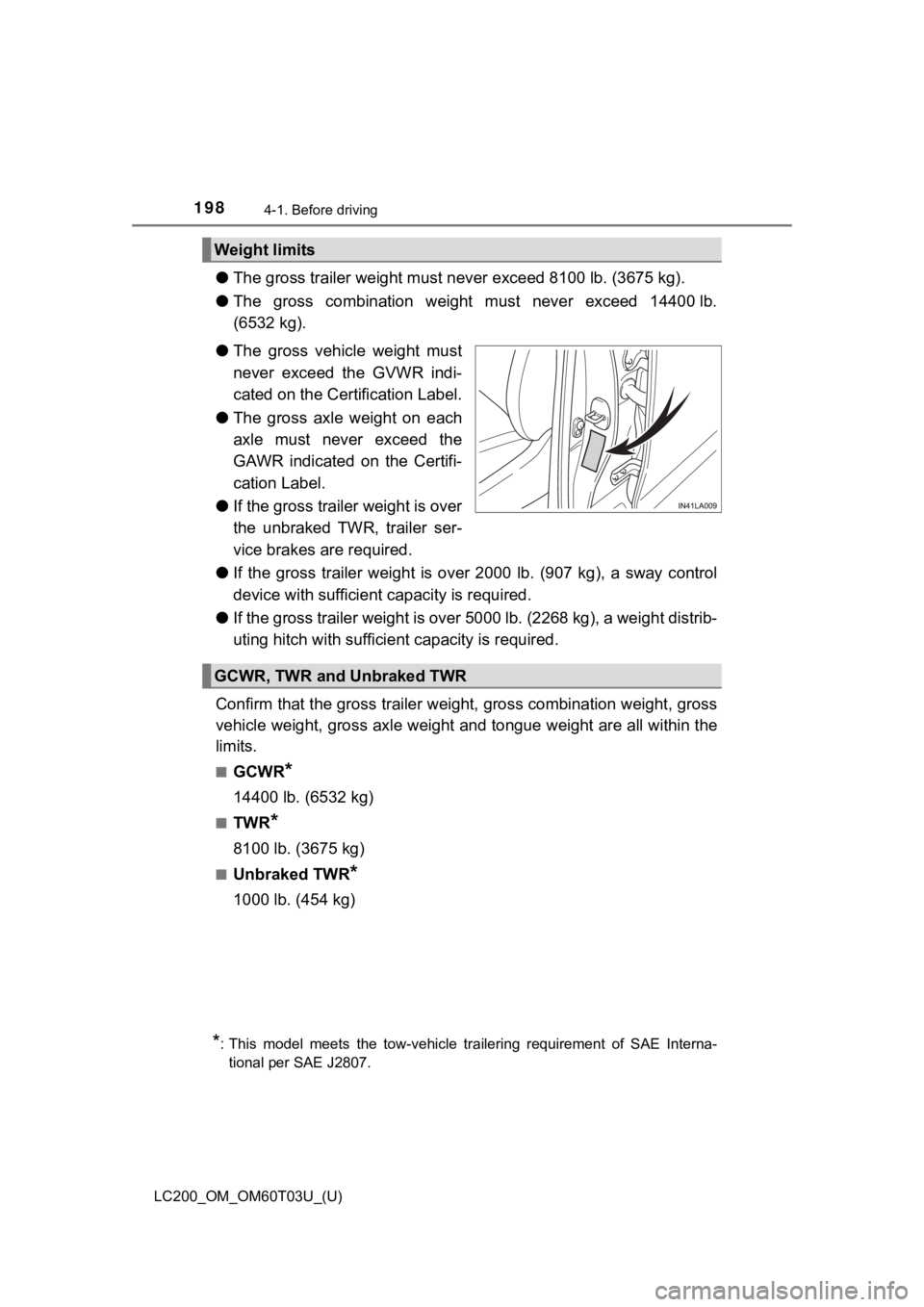
198
LC200_OM_OM60T03U_(U)
4-1. Before driving
●The gross trailer weight must never exceed 8100 lb. (3675 kg).
● The gross combination weight must never exceed 14400 lb.
(6532 kg).
● The gross vehicle weight must
never exceed the GVWR indi-
cated on the Certification Label.
● The gross axle weight on each
axle must never exceed the
GAWR indicated on the Certifi-
cation Label.
● If the gross trailer weight is over
the unbraked TWR, trailer ser-
vice brakes are required.
● If the gross trailer weight is over 2000 lb. (907 kg), a sway c ontrol
device with sufficient capacity is required.
● If the gross trailer weight is over 5000 lb. (2268 kg), a weigh t distrib-
uting hitch with suffici ent capacity is required.
Confirm that the gross trailer weight, gross combination weight , gross
vehicle weight, gross axle weight and tongue weight are all within the
limits.
■GCWR*
14400 lb. (6532 kg)
■TWR*
8100 lb. (3675 kg)
■Unbraked TWR*
1000 lb. (454 kg)
Weight limits
GCWR, TWR and Unbraked TWR
*: This model meets the tow-vehicle trailering requirement of SAE Interna-
tional per SAE J2807.